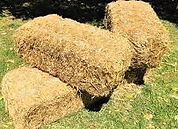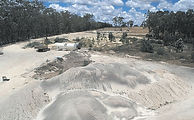
Carbon Coated Mineral (CCM)
The concept of carbon coated minerals was originally developed by Professor Stephen Joseph. The concept arose from the characterisation of the very fertile Amazonian Dark Earths that was being undertaken by the University of New South Wales and Cornell University. They found that the dark earth particles contained a large amount of carbon (now referred to as biochar) surrounded by minerals that were bound together by organic compounds. Research, development and testing of these organo-mineral compounds (which we call carbon coated minerals (CCM) has been undertaken by a number of groups throughout the world.
Mineral-enriched biochar delivers enhanced nutrient recovery and carbon dioxide removal (article by W Buss et al., Communications Earth & Environment, 3(1), p.67. 2022)
https://www.nature.com/articles/s43247-022-00394-w
The sicientists find that biomass enrichment (doping) with refined minerals, mineral by-products, or ground rocks reduces carbon loss during pyrolysis, lowering carbon dioxide removal costs by 17% to US$ 80–150 t−1 CO2, with 30% savings feasible at higher biomass costs. As a co-benefit, all three additives increase plant-available nutrient levels. Doping with potassium-bearing minerals can increase both potassium and phosphorus release. Mineral doping in biochar production therefore offers carbon dioxide removal at lower costs, while alleviating global phosphorus and potassium shortages. This makes it unique among carbon dioxide removal technologies.
Biochar production and burial into soils is a key example of a technology that combines CDR with co-benefits for agricultural yield and the soil environment. Greenhouse gas emission life-cycle assessments confirm biochar’s CDR potential; its global annual carbon dioxide removal potential is estimated at 0.03–6.6 Gt CO2 eq. year.
During pyrolysis, minerals in the feedstock play a pivotal role in catalysing biomass conversion into biochar and assist in carbon stabilisation. The same inherent minerals in biochar also provide nutrients to soil and plants through leaching. Many of the observed influences in agricultural applications have been attributed to this nutrient provision and increased nutrient use efficiency. Plant-available phosphorus (P) is a limiting resource, and efficient resource recovery from residues is needed to overcome nutrient limitations. Therefore, enhancement of P availability in biochar is of particular interest.
The content of inorganic nutrients within biochar can be enhanced by adding specific, refined minerals to feedstock prior to pyrolysis, which can create a slow-release fertilizer or increase biochar's carbon sequestration potential.
The Carbon Coated Mineral (CCM, or BMC - Biochar Mineral Complex)
The high application rates of biochar associated with their high cost put farmers in a difficult situation as they could not gain a return on their investment with this amendment in the first few years after its application. To overcome this constraint, the development of artificially aged BMCs that have a higher mineral content, surface functionality, exchangeable cations, high concentration of magnetic Fe nanoparticles, and higher water-extractable organic compounds is required.
BMC had a significant effect on the plant growth and nutrients (P and N) uptake in shoots at a low application rate (100 kg ha−1). The increase in plant growth appeared due to an increase in P and N uptake in the plants, which could be partly attributed to the increase in mycorrhizal colonisation and improvement of soil biology. It could also be partly attributed to the high concentrations of:
-
magnetic Fe nanoparticles that can increase nutrient availability and decomposition of soil organic matter,
-
labile organic molecules that can be a food source formicro-organisms or signaling molecules that can increase beneficial micro-organisms, germination rates and plant disease resistance, and
-
acidic functional groups (especially carboxylic acids) that can increase nutrient availability.
Source: https://www.sciencedirect.com/science/article/abs/pii/S1002016015300564





Raw material: biomass and natural minerals
Carbon Coated Mineral and Compost Influence Soil Bacteria & Quality
Biochar can be enriched when mixed with manures, clay and minerals. Enriched biochar is high in exchangeable cations such as; (calcium (Ca2+), magnesium (Mg2+), sodium (Na+) and potassium (K+); high in plant available phosphorus and it also has a high acid neutralizing ability. Recently, a study by scientists in Australia and China looked at the effects of biochar-mineral complexes (biochar coated with minerals) combined with compost (poultry manure) on soil bacteria, soil quality and some plant growth properties.
Some results of the study
-
Biochar mineral complex combined with compost (BMCO) increased bacteria population and nutrient levels of the soil. They attributed this increase to the presence of compost in the mixture; as organic manure applied to soil increases microbial population.
-
Comparing the compost only treatments to BMCO there was a higher content of total soluble nitrogen, organic carbon, nitrate and available potassium in the BMCO than the compost. In particular, soil nitrate was double the amount in BMCO than in the compost pots. They explained that the increased nitrate levels in BMCO, were as a result of increased soil nitrification caused by the abundance of nitrifying bacteria. Nitrification is a process in the nitrogen cycle which ends with the release of nitrate (the plant available form of nitrogen) in soil.


